9 Days in Iceland: The Perfect Road Trip Around the Ring Road
Iceland is a country that feels like another planet: black sand beaches, active volcanoes, powerful waterfalls, endless lava fields, and glaciers that stretch into the horizon. If you have the time for it, the best way to experience it all is by taking a road trip around the Ring Road, a route that circles the island and connects the country’s most famous highlights. We started in Reykjavík and spent 9 days driving around Iceland, stopping at waterfalls, national parks, and small fishing villages along the way. Here’s a day-by-day itinerary that will take you around the whole island. This trip is optimized for summer, when you can travel through the road and have plenty of sunlight.
- Itinerary
- Day 1 – Arrival in Iceland and relaxing in the Blue Lagoon
- Day 2 – Reykjavík and the Golden Circle
- Day 3 – South Coast Highlights
- Day 4 – South of Iceland
- Day 5 – Exploring the Glaciers in Iceland
- Day 6 – The East of Iceland
- Day 7 – Akureyri & North Iceland
- Day 8 – West Iceland
- Day 9 – Return and visit to Reykjavík
- Final Thoughts
- Practical Tips for Driving Iceland’s Ring Road
Itinerary
Day 1 – Arrival in Iceland and relaxing in the Blue Lagoon
We landed in the Keflavík Airport, near Reykjavík in the afternoon, and after grabbing our campervan in the airport, we headed towards the countryside to explore this beautiful country.
Gunnuhver – fumarole
Gunnuhver is an interesting geosite with a fumarole. It’s quite close to the airport, so it was a natural first stop before heading to the Blue Lagoon. This place is part of the Reykjanes UNESCO Global Geopark, and has multiple exhibitions, craters, and powerplants. We only did the short hike next to the fumarole, for no other reason that due to how the wind was blowing, all the smoke went over the hiking path. Unpleasant in the moment (it stinks), but a fun memory.
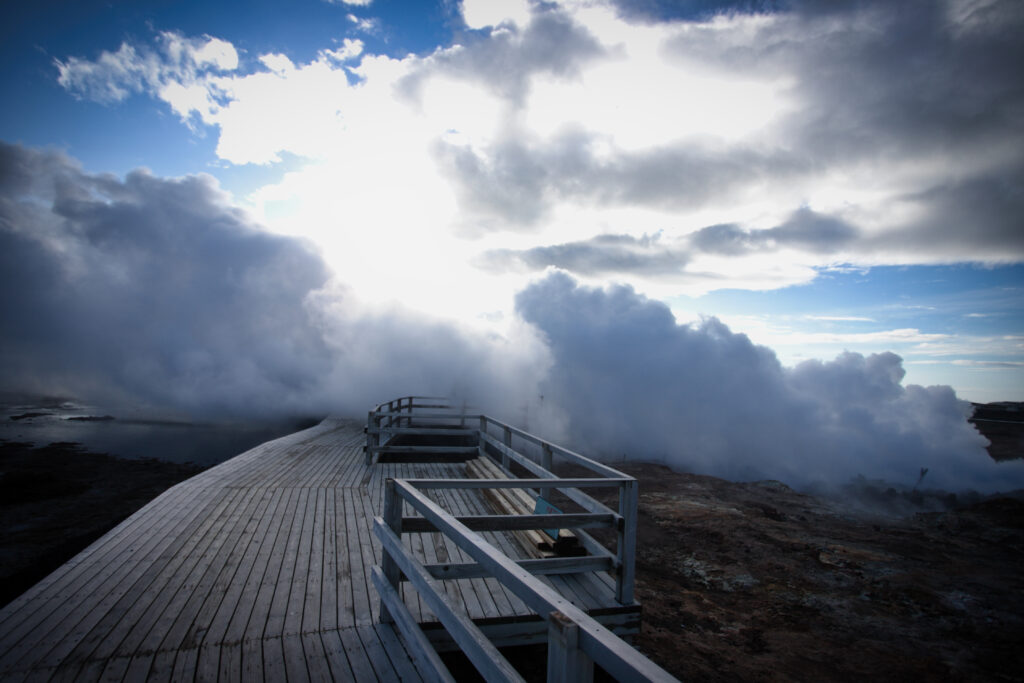
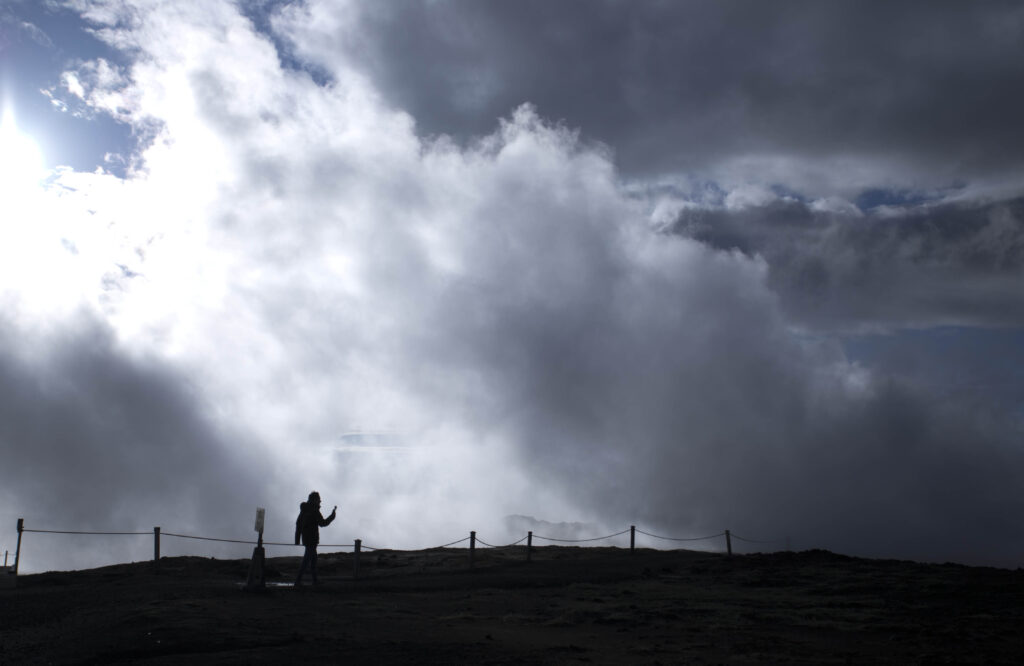
Blue Lagoon
A rather touristy activity but a fun one nonetheless: visiting the Blue Lagoon. It’s not cheap (starting at 70€ in 2025), but it’s worth doing at least once. Alternatively, you can go to the Myvatn Nature Baths, which are on the opposite side of the island and are cheaper (see Day 7). The basic ticket for the Blue Lagoon includes the use of the lagoon, a mud mask, and a drink, and you have others with included toiletteries or different sauna and spa types.
When we went, the outside temperature was 11ºC (cold for me), so getting into the water (around 37ºC) was really pleasant. The lagoon was also much larger than I imagined it, and at the time we went (around sunset time) there were not so many people any longer. Most of the people gathered closer to the entrance or next to the bar and mud masks, so it was easy to walk around and find a more intimate spot. The water is not particularly deep anywhere, being less than 1.3 m overall.
People with long hair – beware! Due to the rich minerals of the blue lagoon, your hair will be extremely dry if you put it in the water. In the showers they provide you conditioner, but really consider if the cool photo of you immerse in the water is really worth the hassle of getting your hairr back to normal.
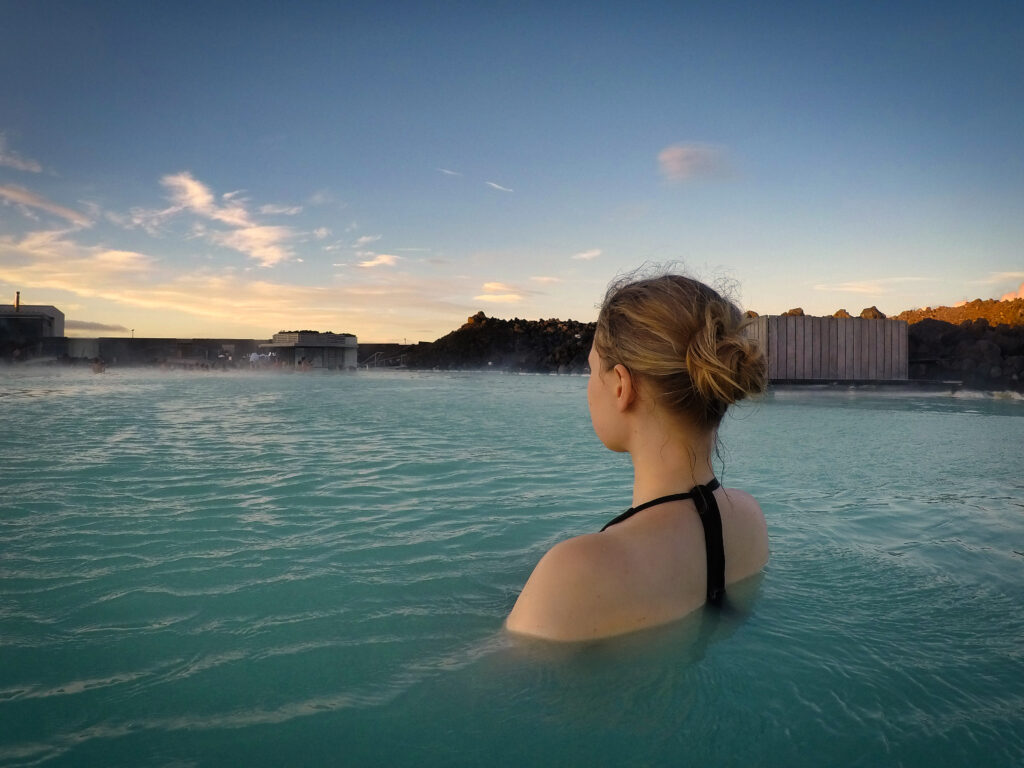
Day 2 – Reykjavík and the Golden Circle
Reykjavík
Reykjavík is the largest city of Iceland, with almost 140,000 inhabitants, and its capital. The most famous sight in Reykjavík is the Hallgrimskirkja, an Evangelical-Lutheran church. While the interior of the church is not particularly exciting, the building is absolutely stunning. The church was designed by Guðjón Samúelsson in the early 20th century, drawing inspiration from the country’s nature. You can also visit the tower, which at 73 m offers views of the city.
Other attractions of Reykjavík include visiting the Harpa Concert Hall, a beautiful modern building located near the sea, used mostly for events. Nearby you can see the Sun Voyager sculpture, created by Jón Gunnar Árnason in 1990. It’s supposed to represent a dreamboat (not a viking boat), a symbolism to exploration, freedom, and humanity. While certainly you can see more things in Reykjavík, including several museums, we decided to continue our trip to enjoy the higlight of Iceland: its nature.
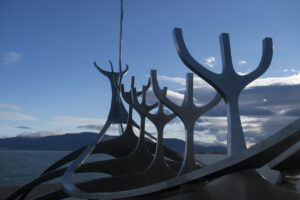

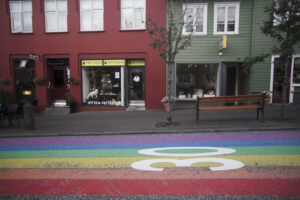
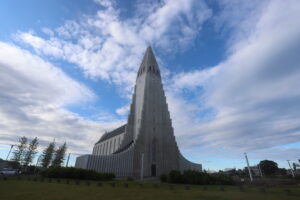
Þingvellir and Oxararfoss
A classic destination for first-timers in Iceland is the Þingvellir National Park, a UNESCO site where you can see the rift between tectonic plates. It’s a national park, located only 40 km away from the capital. Þingvellir is not only the place where you can see the tectonic plates, but it’s also the birthplace of the icelanding parliament. Here, you’ll see one of the first waterfalls of the trip: Oxararfoss. While I didn’t do it myself, I’ve seen that you can dive between the tectonic plates in the Silftra region. That sounds like a really cool experience!
I can’t say this stop was a favorite of mine, as scenically it was not one of the most impressive places, but it certainly has its historical and geological significance. It was also really crowded, likely due to the proximity to Reykjavík.
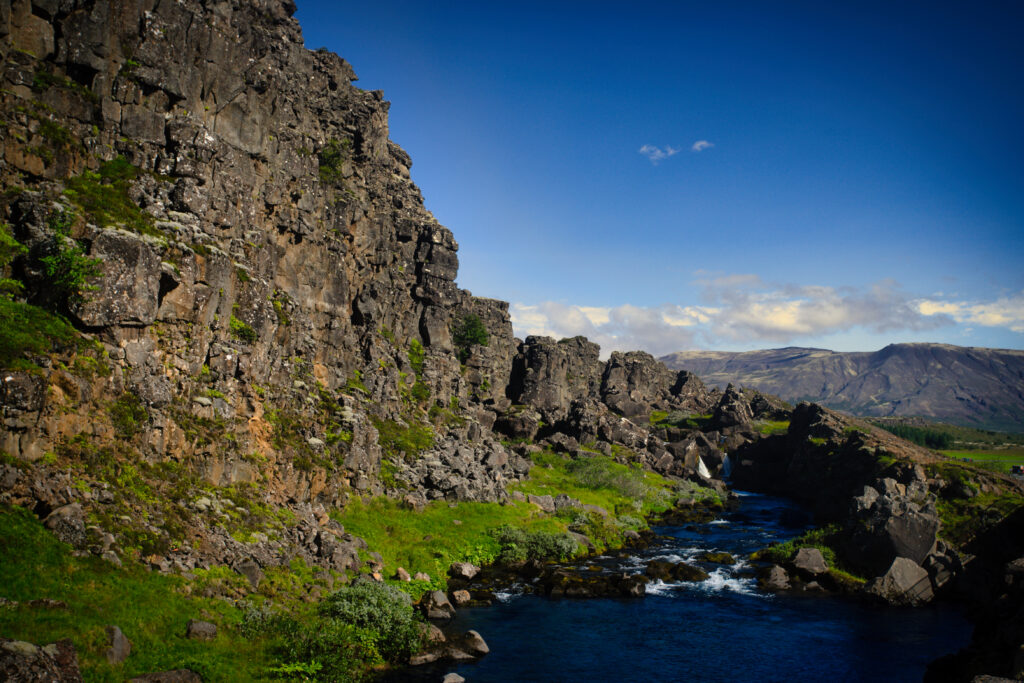

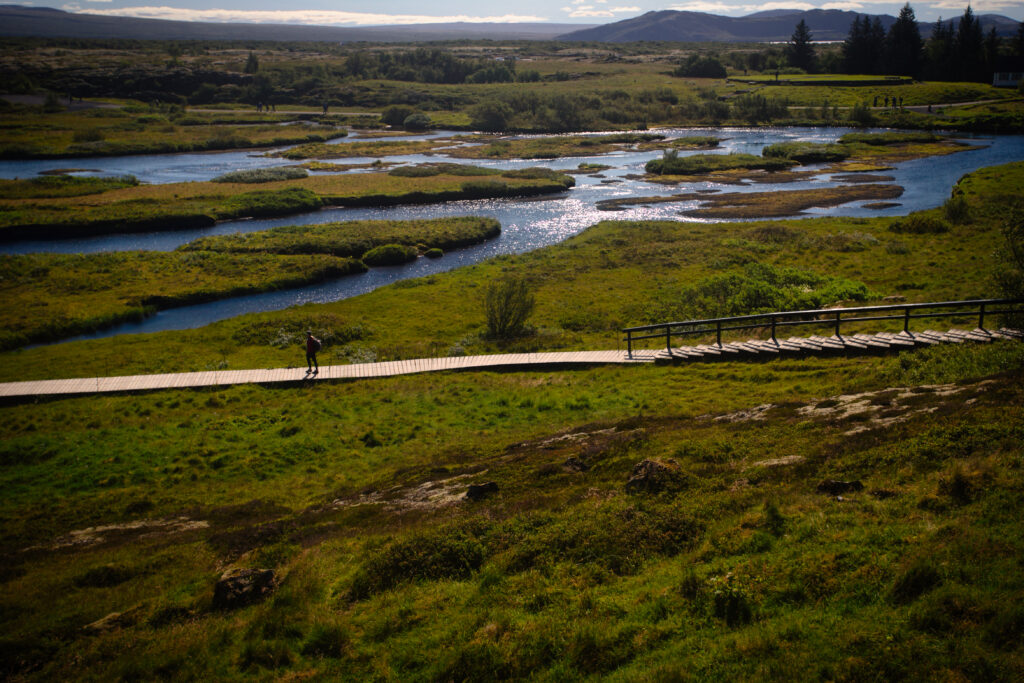
Bruarfoss Waterfall
Bruarfoss is a small waterfall, less crowded than others despite the beautiful blue color of the water. The waterfall is located a short walk away from the car (around 10 min). You can see the waterfall from a small bridge that connects the two sides of the river, or just descend to the river bank. The closest town to Bruargoss is Laugarvatn, which can be a good place to eat something or spend the night.
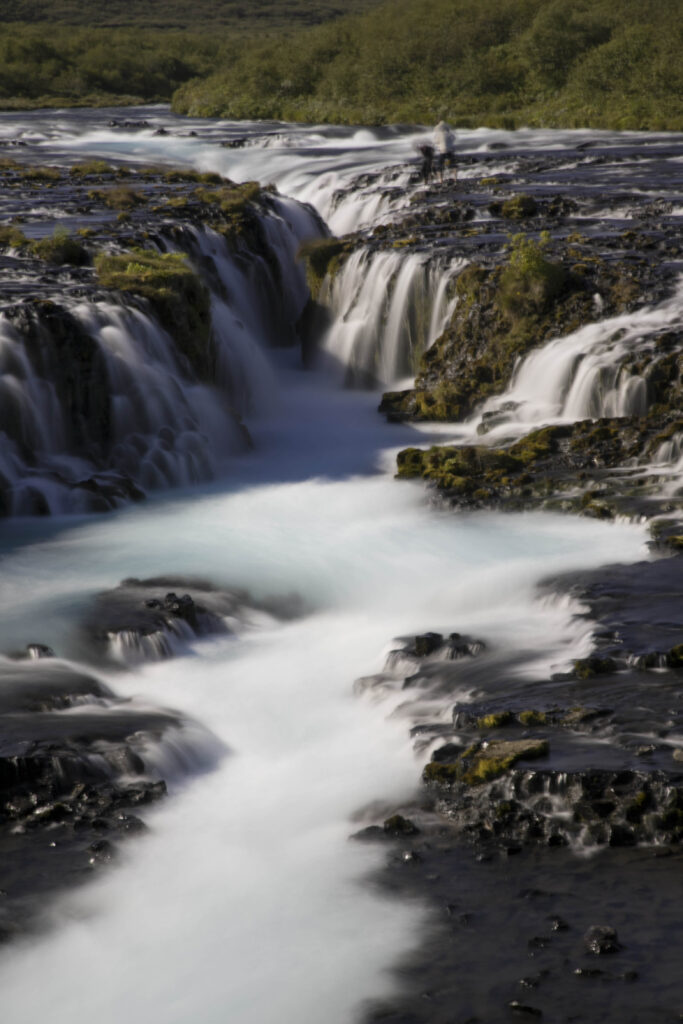
Geysir geothermal area to watch Strokkur erupt
This is one of the most famous stops in Iceland, and where the word geyser comes from. The original Great Geysir is mostly dormant, but Strokkur erupts every 10–15 minutes, shooting boiling water 20–30 meters in the air. It’s really fun to watch, and since it’s so frequent, you can easily catch multiple eruptions from different angles. They’re not always very high though, so if you want to see one that is very impressive you may need to wait for a bit. The geothermal area has several other bubbling mud pools and steaming vents, so take some time to walk around. Nothing to envy to other geothermal areas, like Yellowstone.
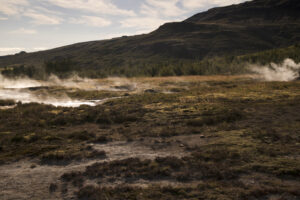
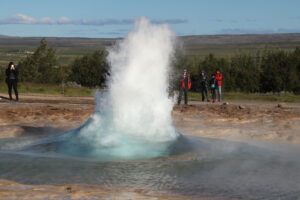
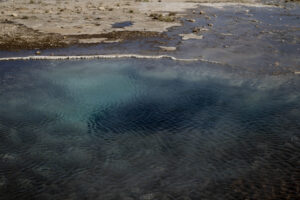
Gullfoss waterfall
Only a short drive from Geysir, Gullfoss is one of the most powerful waterfalls in Iceland and a true highlight of the Golden Circle. The Hvítá river plunges in two tiers into a canyon, and you can see it from above or walk closer to the edge for dramatic views. On a sunny day, rainbows often appear in the mist. The paths are well marked and the viewpoints are easy to reach. As it’s part of the Golden Circle, this waterfall is also quite crowded.
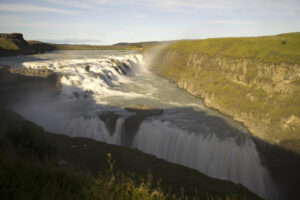
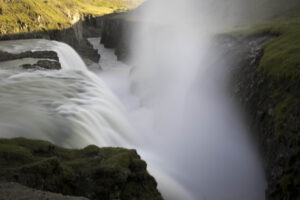

Kerid
Kerið is a volcanic crater lake with vivid red and green slopes surrounding a striking blue pool of water. It’s not as large as some other craters, but the colors are beautiful. This lake was formed after a volcano erupted, leaving an empty magma chamber that then collapsed and formed the current crater. Since it’s located in private lands, the entrance is a few euros, but it’s worth it as part of your Golden Circle loop. You can also go down to the crater, as there’s a staricase that leads you there.

Seljalandsfoss
On the way east towards the South Coast, don’t miss Seljalandsfoss, one of Iceland’s most iconic waterfalls. The special thing here is that you can walk behind the waterfall. The path can be slippery and you will get soaked, but it’s a magical experience. The best time to visit is late afternoon when the sun shines through the water and there’s less people visiting it.

Day 3 – South Coast Highlights
Skógafoss
Just down the road from Seljalandsfoss lies Skógafoss, another must-see waterfall. It’s huge, wide, and powerful, dropping 60 meters into a pool below. On sunny days, rainbows appear in the spray. You can also climb a staircase to the top for a different perspective. If you have time, the trail from here leads into the Fimmvörðuháls hike, a beautiful trek.
There’s quite a few accomodation options nearby Skógafoss, including a camping and some hotels. Nothing better than waking up early in the morning to enjoy the waterfall in some solitude!
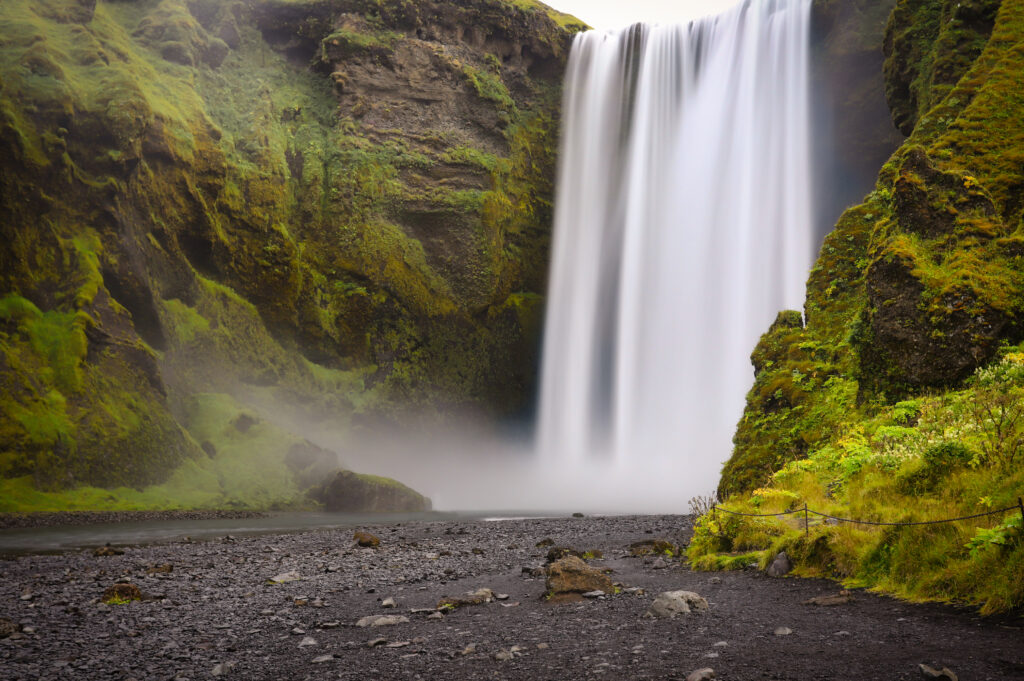
Cave tour near Katla
When I was preparing for the trip, I was a bit disappointed as visiting an ice cave is usually considered a winter activity. That was until I saw that it’s also possible to do in summer (if the tour agency finds a suitable cave)! I excitedly booked with Glacier Guides for the adventure in the Katla region. We started our tour from Vík, and they drove us off-road towards the black glacier. The drive was increadibly scenic, with the green of the mountains contrasting with the black of the glacier. We prepared for entering the cave, with some helmets and crampons, and split into smaller groups, as our cave was quite tiny. The cave inside was nice, pretty blue, and looked bigger in the photos than it was in reality, so it was quite fast to see. It was my first ice cave visit, so I was pretty excited, but it wasn’t the most impressive cave, as in winter they are larger (Also check out these caves in Austria if you want to see some in continental Europe).
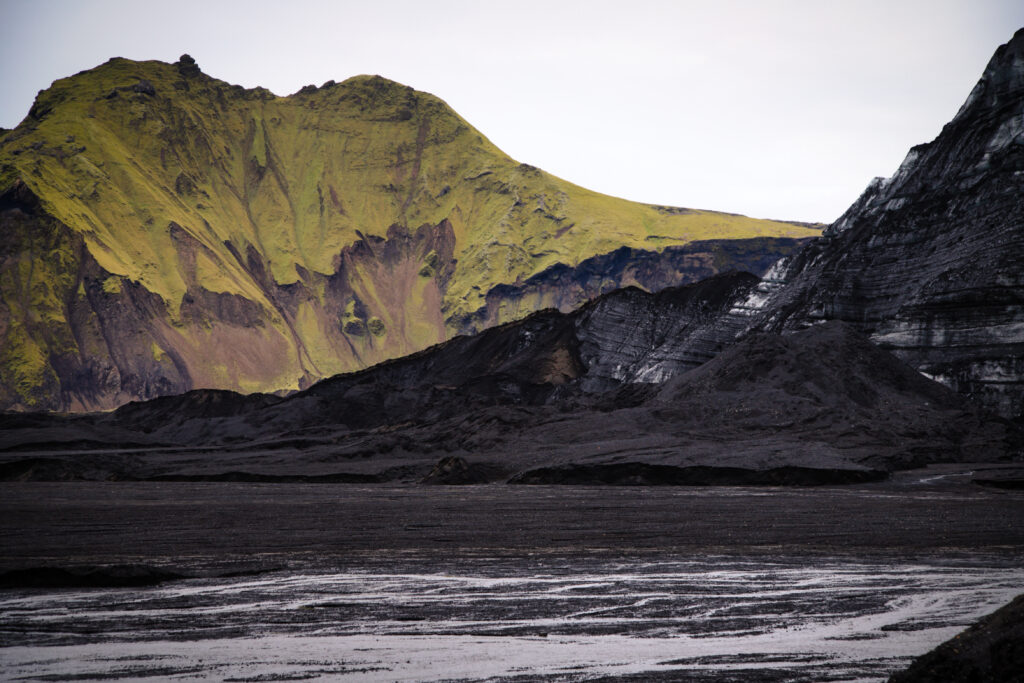
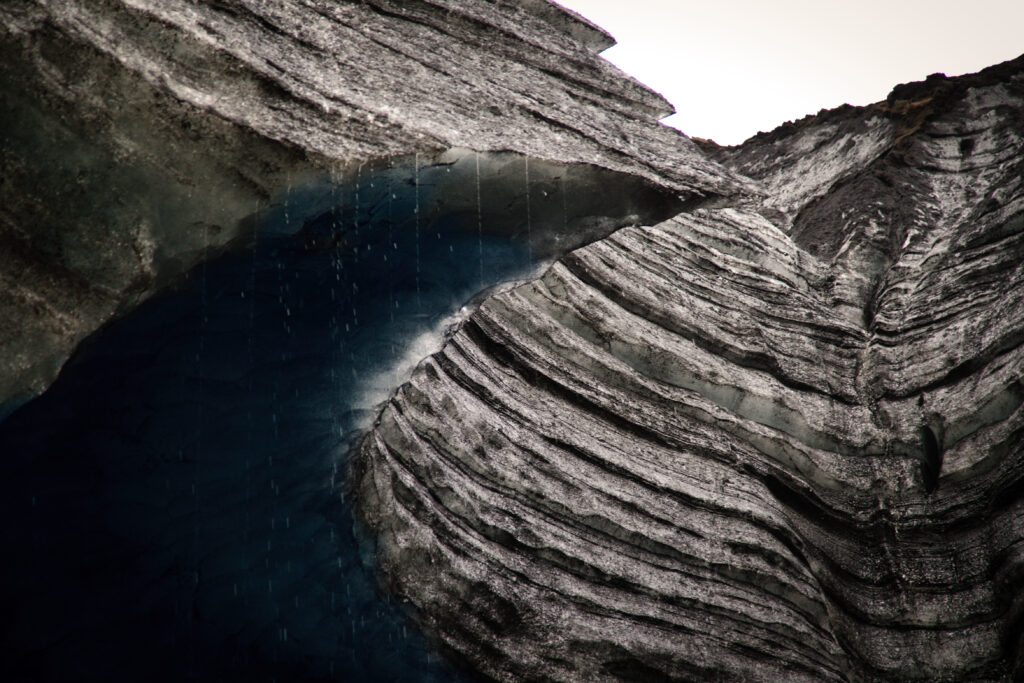
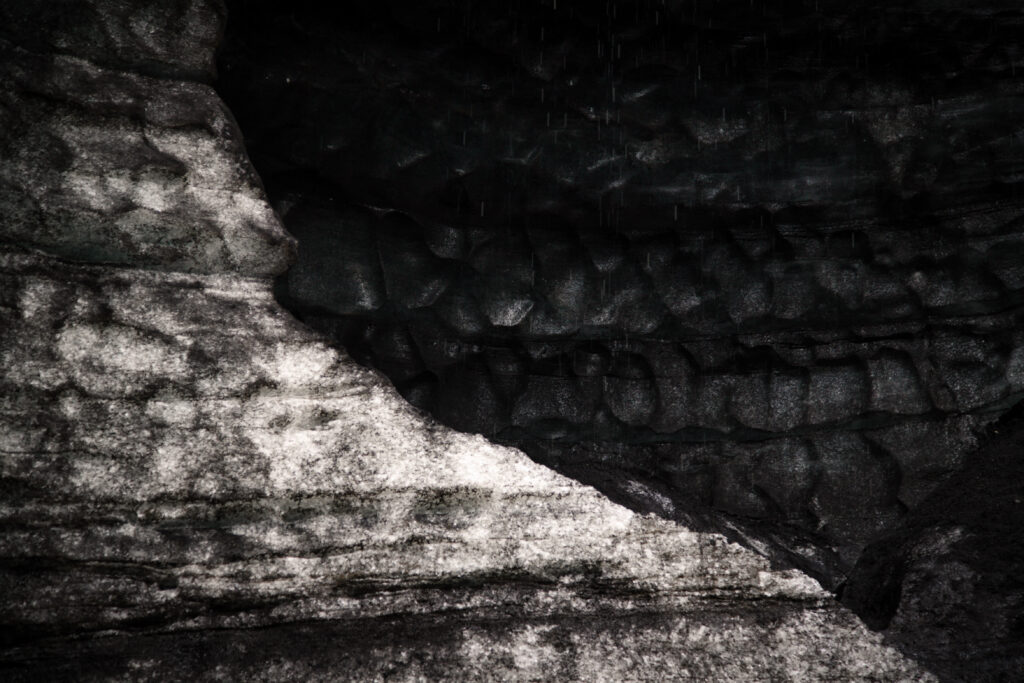
Wrecked DC-3 Plane
In 1973, a US plane crashed into this sandy beach in the south of Iceland. Fortunatelly, everyone survived the crash, and the plane was left there as a touristic attractions. Nowadays, it’s one of the most popular attractions in the island. The plane wreck is really cool to see and you used to be able to climb over and go inside (not anymore, though). Since it’s so popular it’s also a very crowded destination.
Nonetheless, this nice landmark comes with one of the most boring hikes I’ve ever done. The hike to reach the crash site feels never ending. We parked at a parking lot next to the road, which had an informative panel about what’s waiting for you to set expectations clear. Then, you’ll be walking on a desertic landscape with no features. It’s flat behind you, it’s flat in front of you. Eventually you see the plane, but don’t be too happy yet – it’s still a long way. The total trip back and forth about 3 h hours. There’s also a bus that drives you there, which may seem overpriced, but that’s because you haven’t done the hike.

Dyrholaey
A promontory near Vík with a giant sea arch carved by the ocean. From here you get sweeping views of black sand beaches stretching for kilometers, as well as puffins nesting on the cliffs in summer. It’s one of the best photo spots on the South Coast.
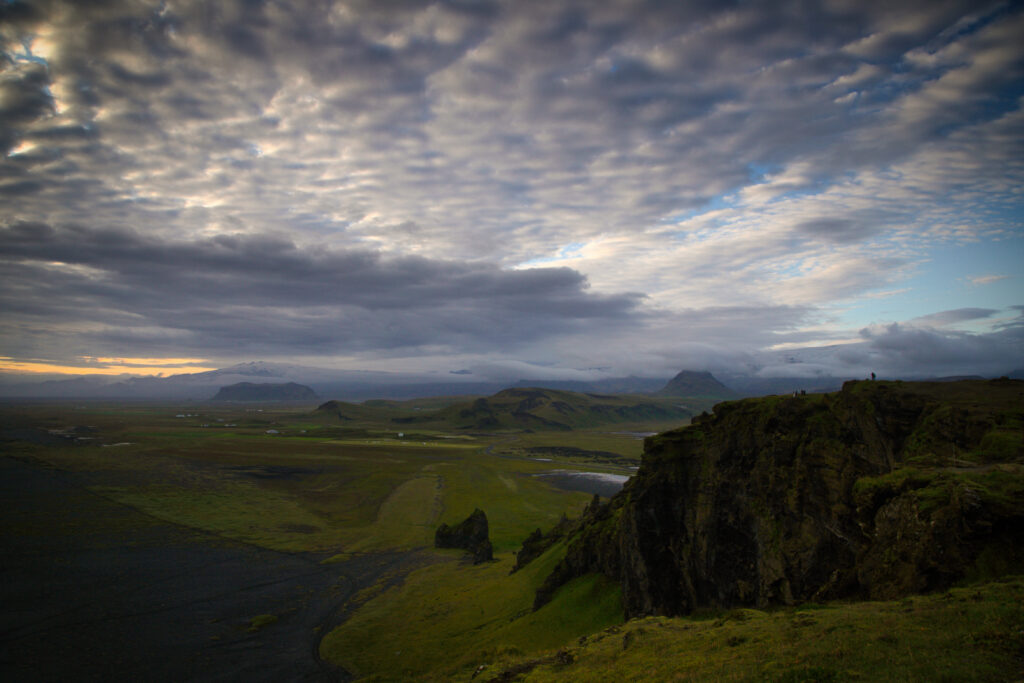
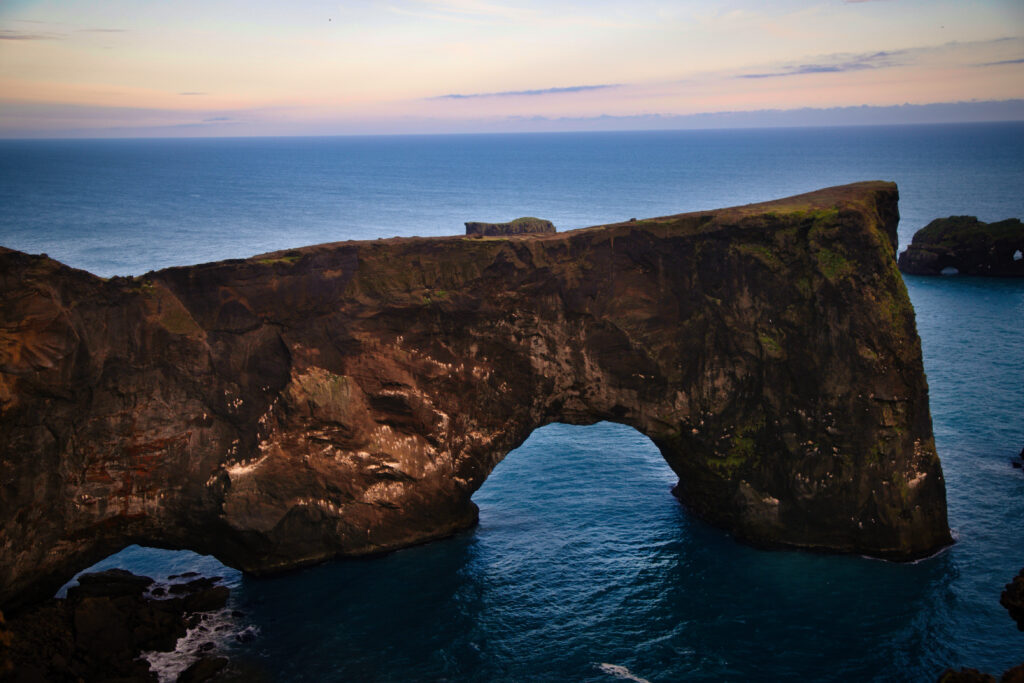
Reynisfjall
The Reynisfjall mountain and Reynisfjara beach are famous for their dramatic basalt columns, black sands, and sea stacks rising from the ocean. It’s a very famous landscape and you’ll want to climb the beautiful basalt columns, which make a great backdrop to your photos.
While it looks like a relaxing and peaceful beach, be very careful here: sneaker waves are dangerous and many people have lost their lives by getting too close. There’s several boards letting you know to be careful, and noneless we saw many people with their feet in the water.

Day 4 – South of Iceland
Fjadrarfljufur canyon
This spectacular canyon looks straight out of a fantasy movie. It’s about 2 km long and 100 meters deep, with a trail along the top offering great viewpoints. The trail is restricted to parts you can visit due to massive tourism, but this way the canyon looks gorgeous for all of us. You can see the canyon after a short walk from the parking lot.
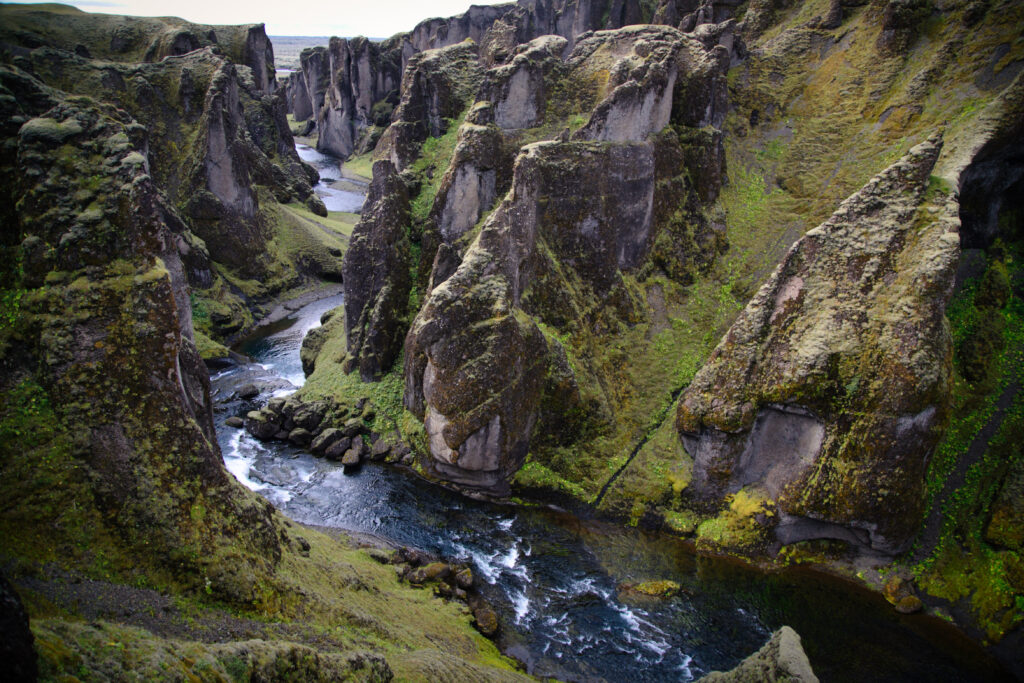
Kirkjugólf
Next to a gas station there is a natural pavement of basalt columns that looks like a man-made tiled floor. It’s small but interesting, and makes for a good quick stop.

Lomagnupur
A dramatic cliff rising almost vertically from the flat plains around it. You can’t miss it when driving by – it’s one of the most photogenic mountains on the Ring Road. That being said, there’s only that, so it’s a pretty quick stop unless you’ve decided to wait for the best weather conditions for a photo.
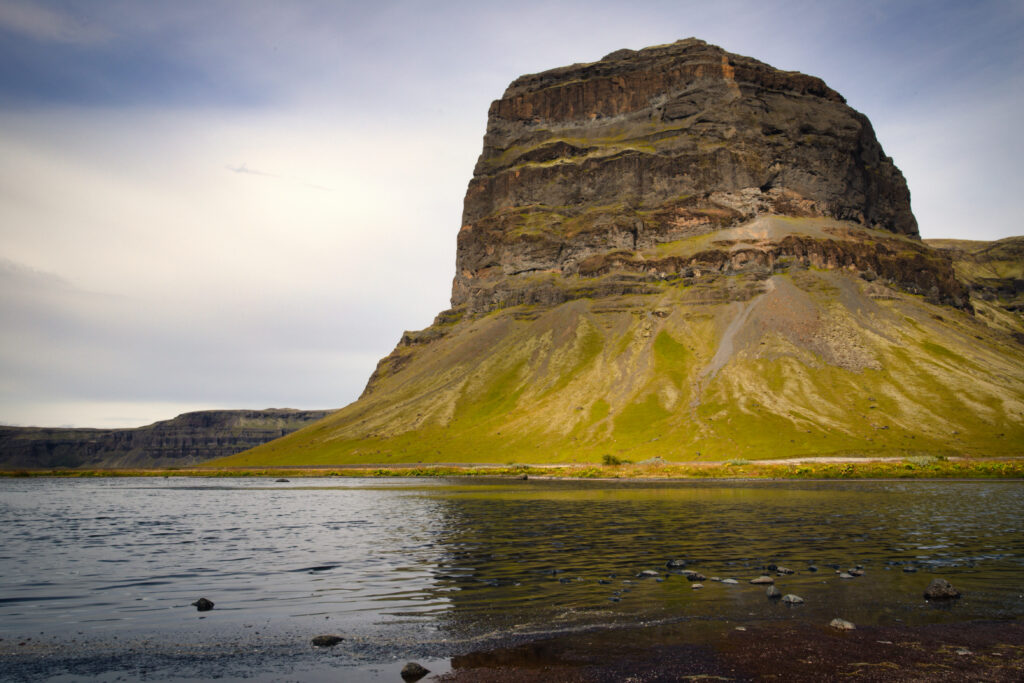
Skaftafell
Part of Vatnajökull National Park, Skaftafell offers several hiking opportunities, from short walks to glacier viewpoints to longer treks. The most popular spot is Svartifoss, a 20 m waterfall on dark basalt columns. The hike to the waterfall is around 1.5 km in each direction. Since it’s such a popular area, it’s also very crowded.
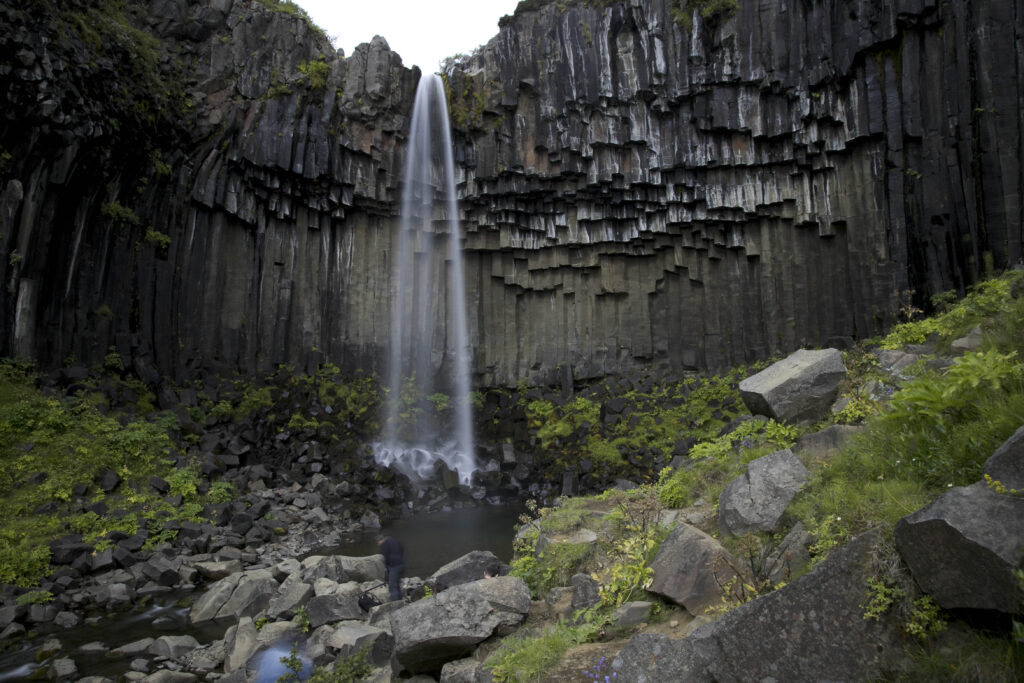
Fjallsarlón & Jokilsarlón
These two glacial lagoons are incredible places to see icebergs. The lakes were formed after the glaciers started to recede. Jökulsárlón is the bigger and more famous one, where you can even take a boat tour between the floating chunks of ice. Fjallsárlón is smaller and quieter but equally stunning. Here, you can see the icebers floating towards the sea.


Diamond beach
Next Jokilsarlón, you reach one of my favorites in the trip: the Diamond Beach. The icebergs from the lagoon wash up on the black sand beach, glittering like diamonds in the sunlight. It’s one of the most special sights in Iceland. It was also very windy and cold, being so close to the ocean.
Be aware! The beach does not always have ice on it. So don’t miss it for a later time if you see it’s full of ice pieces. We drove by the next day after our first visit and there was no ice any longer on the beach.
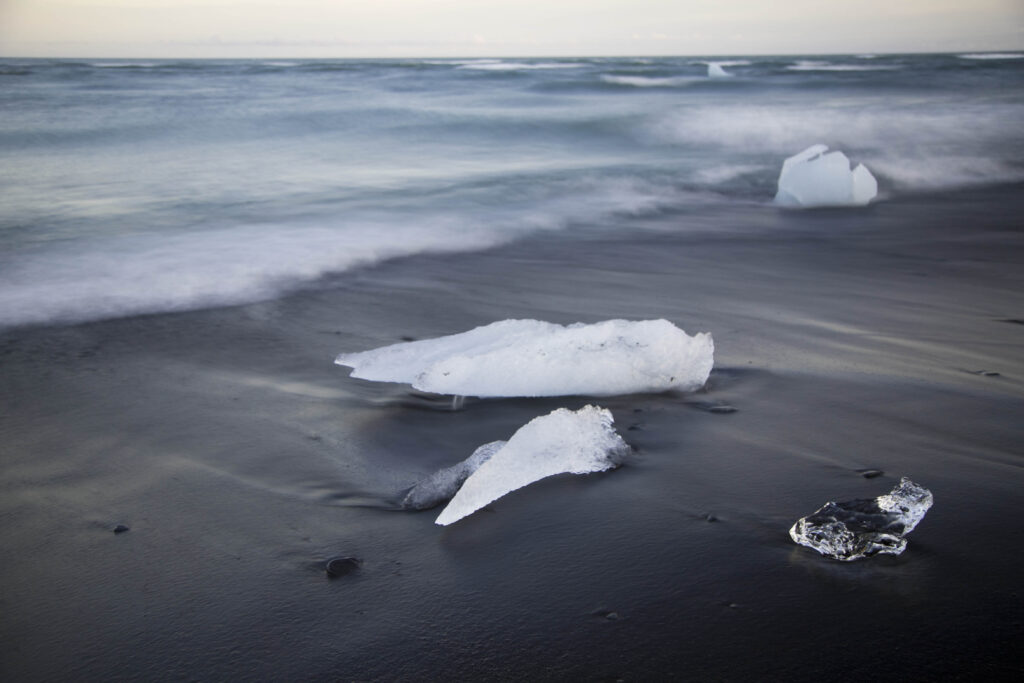
Day 5 – Exploring the Glaciers in Iceland
Glacier walk
I love seeing glaciers from close by – they are so impressive! So what better than going to a glacier walk? We took the beginner tour, and whole trip took around 3 h, which included the trip to and from the glacier. They gave us an ice axe, but it was more for the show – the crampons were plenty. The weather did not accompany, but otherwise the tour was really exciting! It was a bit scary as a first timer on ice to descent what I know is a slippery hill with crampons, but they really secure you well.
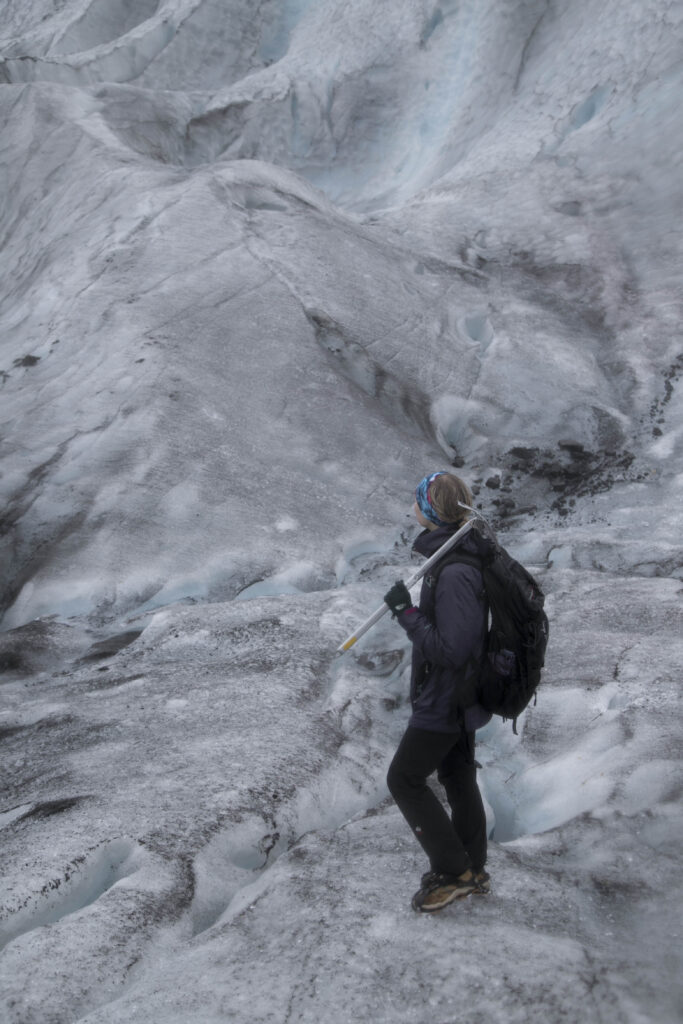
Fláajökull
After finding this place in our guidebook, 2e somehow managed to drive through an 8 km gravel road. It was not an F-road but felt like it. We finally reached a parking spot, which was quite empty (only one other car with people!) and then proceeded to hike up next to the glacier. It’s a really cool experience! Fláajökull is a small glacier tongue, which has also been receding over the last years, but still looks really impressive.
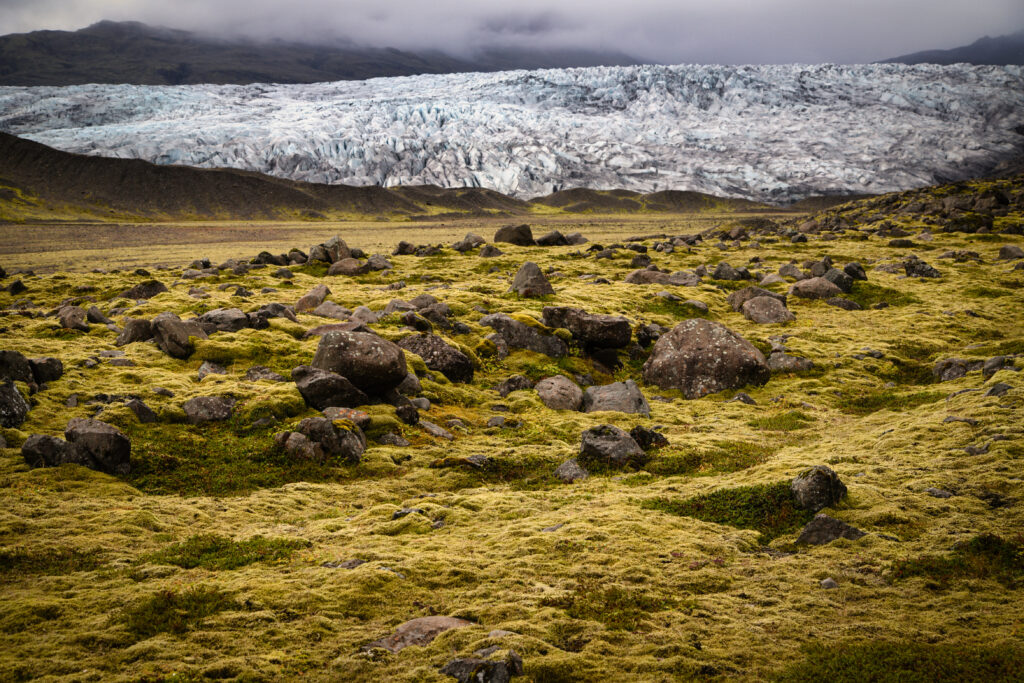
Vesturhorn
Vesturhorn is one of Iceland’s most photographed mountains, located near Höfn. It’s located on private land, so you’ll have to pay an entrance fee to get to the land. The mountain contrasts nicely with the black sand beach. There’s a camping site right next to Vesturhorn, so if you want to catch the sunrise and sunset here, it’s your place to stay!

Day 6 – The East of Iceland
Djupivogur
Djupivogur is a small town on the east of Iceland. It’s a great place if you want to take a break for a restaurant or visit a café. One of the highlights of Djupivogur are the sculptures of the 34 eggs along the coast, called Eggin í Gleðivík.
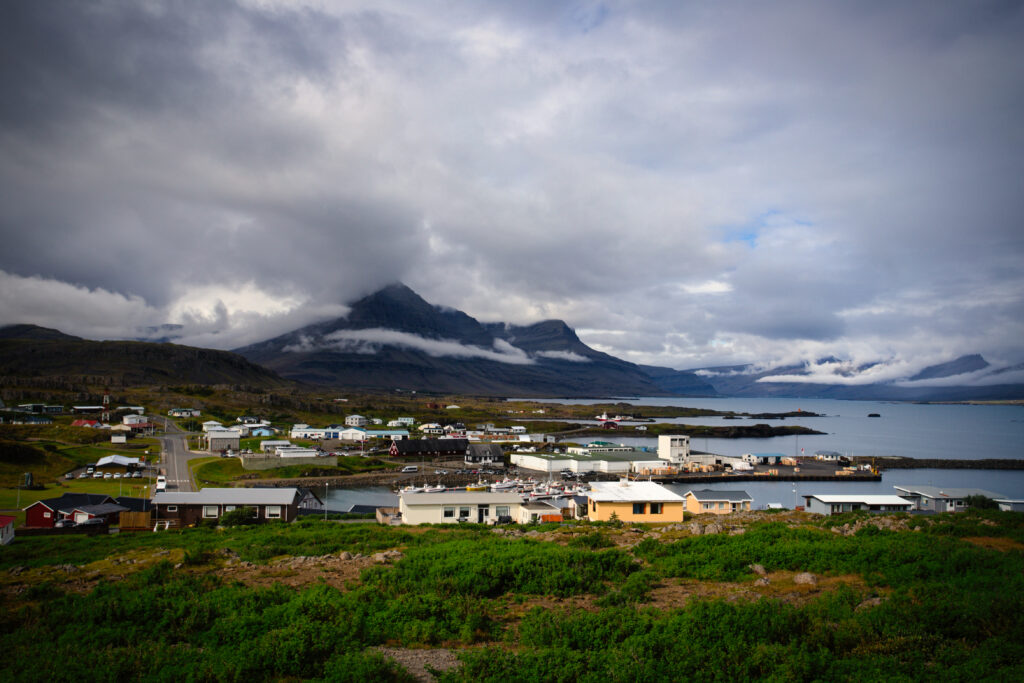
Flögufoss
One hour away from Djupivogur, you can find the hike to Flögufoss, a 60 m tall waterfall. There’s a parking lot about 15 min away from the waterfall, which is an easy hike.
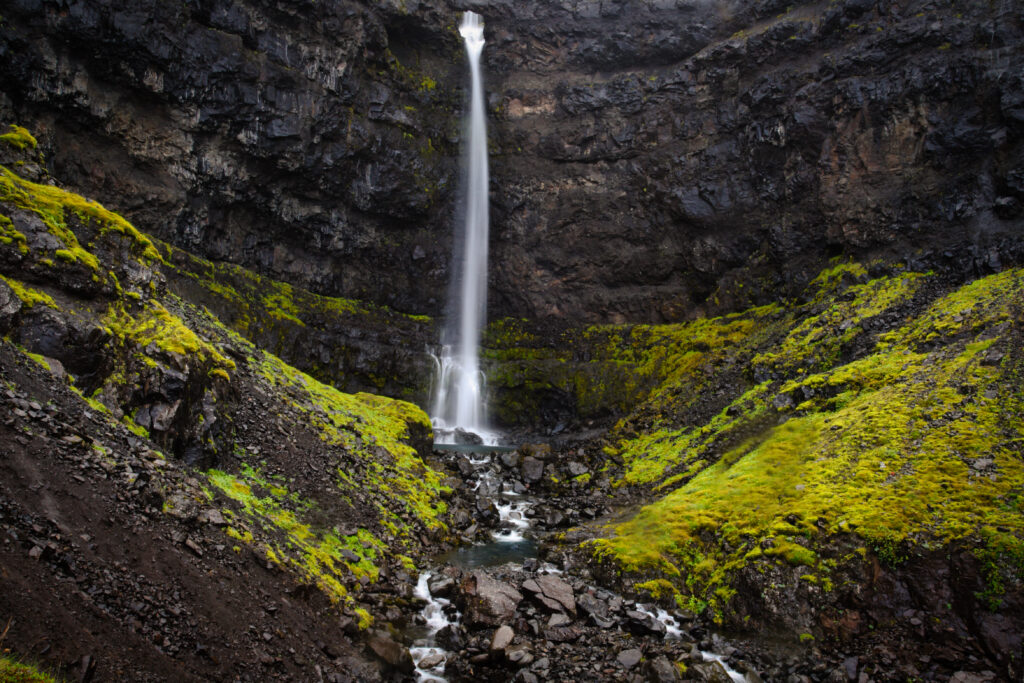
Hengifoss and Litlanesfoss
After another hour of traveling, you can reach Hengifoss and Litlanesfoss. There is a parking lot, from where you can start the hike. Litlanesfoss comes first – it’s a waterfall surrounded by basalt columns, and is 30 m tall. If you continue on the path, you’ll reach Hengifoss, a 128 m hike, is the end of the hike. The special thing about this waterfall are the red stripes it presents, made out of oxidized clay. The total hike length is around 5 km, with the path going up to reach the waterfall.
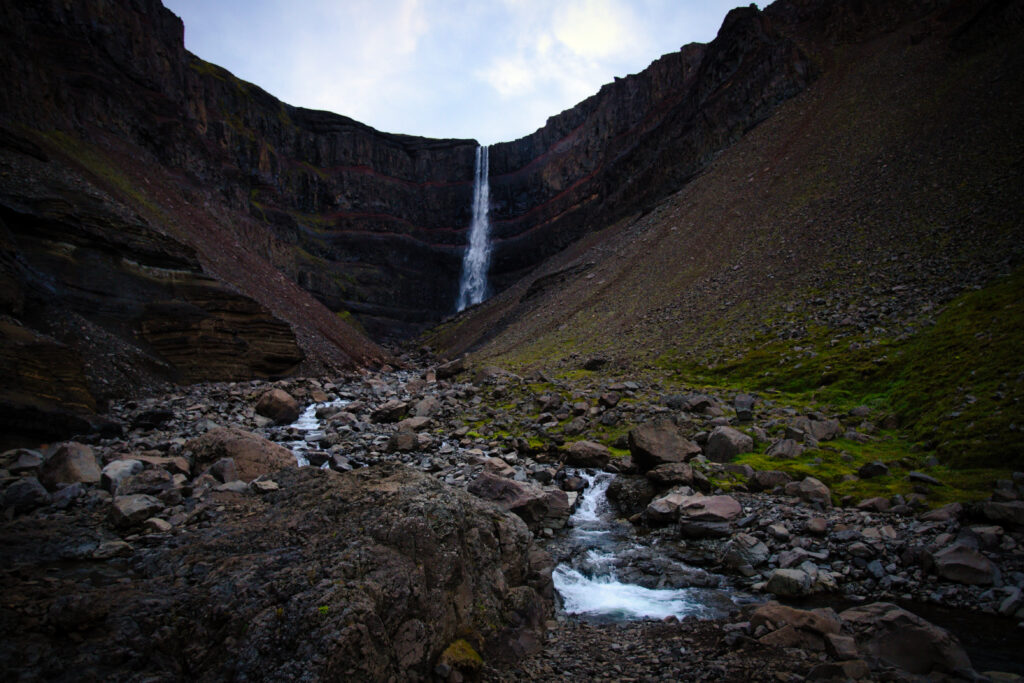
Day 7 – Akureyri & North Iceland
Dettifoss and Selfoss
Dettifoss is the so-called most poweful waterfall in Europe, with 100 m wide and 45 m tall. There’s two routes towards Dettifoss, one from the West (paved road number 862) and one from the East (gravel route number 864) – this means that road conditions are better from the West side. The East side is usually closed in winter. In the same stop you can see Selfoss, located around 1 km away from Dettifoss. Although it has a fall of only 10 m, it also had what seemed to be a never ending waterfall from both sides.
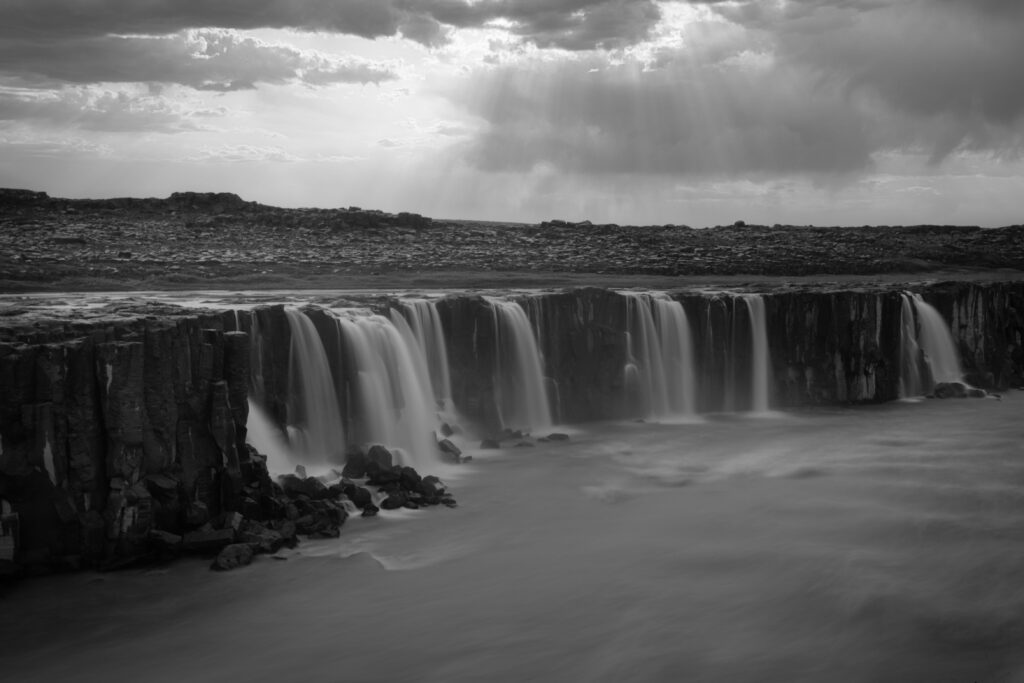
Krafla Viti Crater
This 300 m in diameter crater was formed during an eruption in 1724 that lasted 5 years. It’s popular due to its very blue waters, product of the elements present in the area due to it being an active geothermal zone. The Kraftla Vití crater is easily accessibly by road.
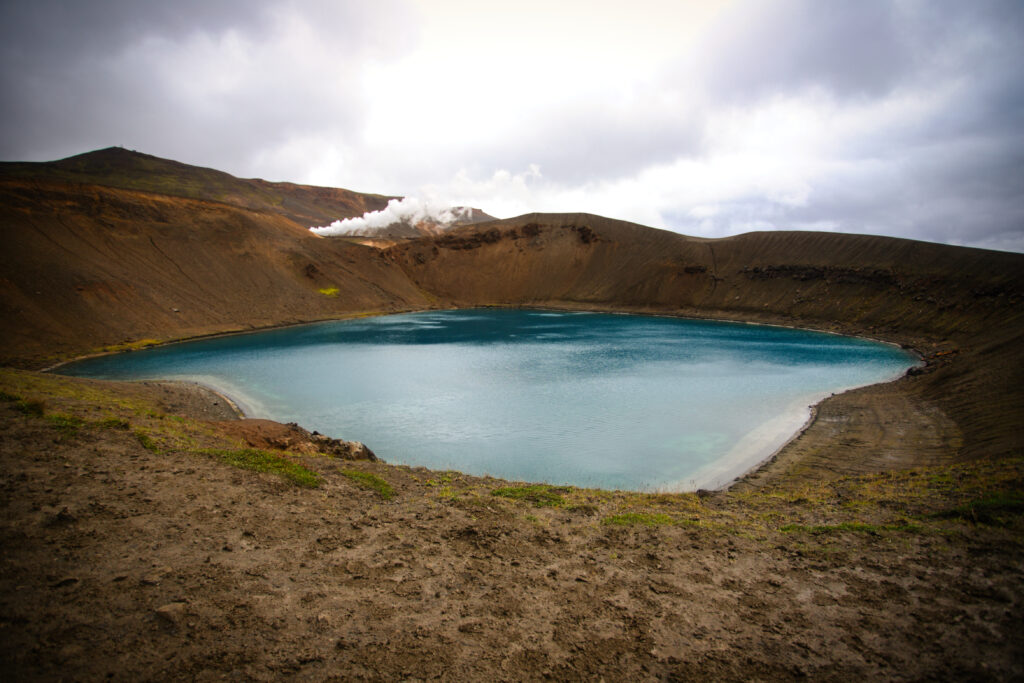
Leirhnjúkur
Really cool volcanic landscape from this still active volcano. The last eruption was in 1984. This area has an easy 3.9 km hike around the volcano caldera, which allows you to see all the geothermal area.
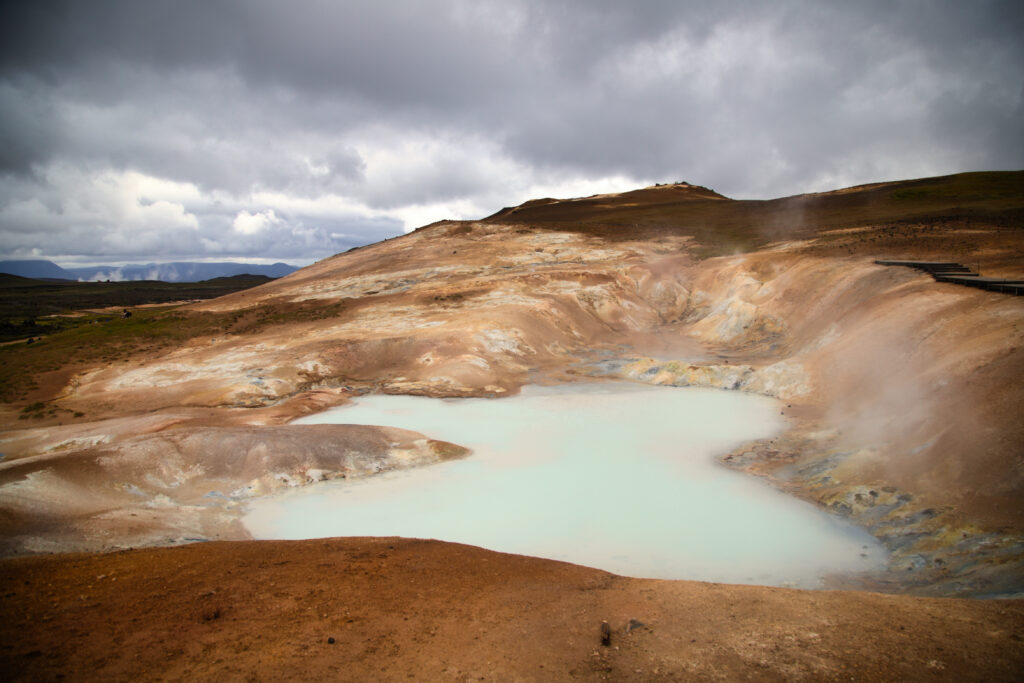
Hverir
Also part of the Kratla volcano, Hverir is a geothermal area located nearby the Lake Myvatn. Hverir has plenty of fumaroles and mud pots, which leaves an interesting smell around the place.
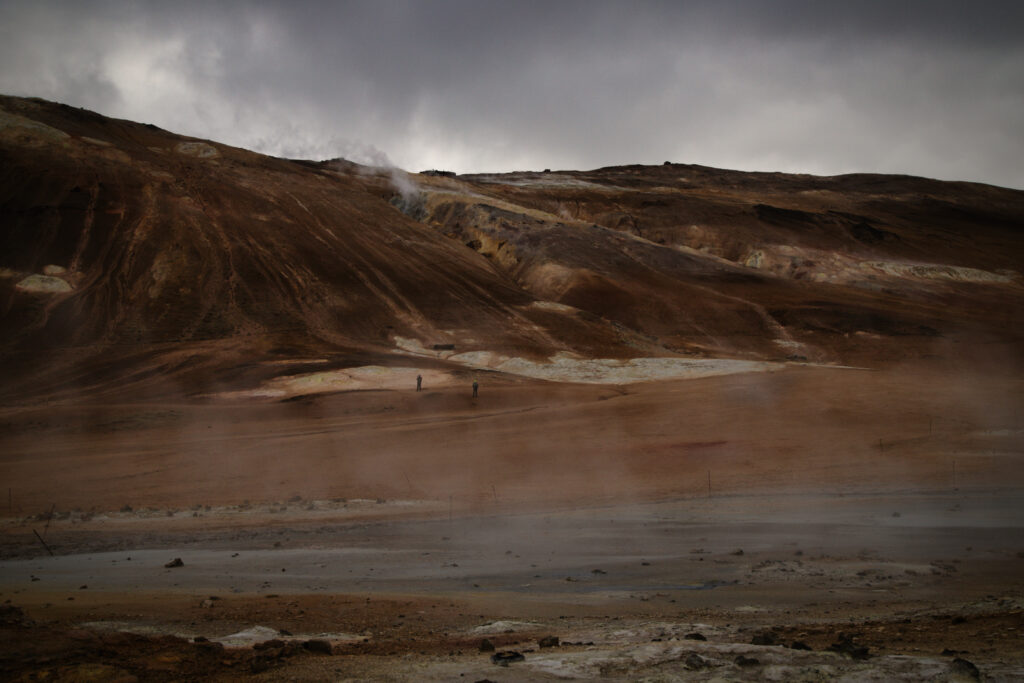
Grjótagjá
This small lava cave with a hot spring inside became famous for being a filming location in Game of Thrones. One used to be able to swim here, but can’t anymore. It’s also really warm inside, so you camera might get humidity in, be careful with that.
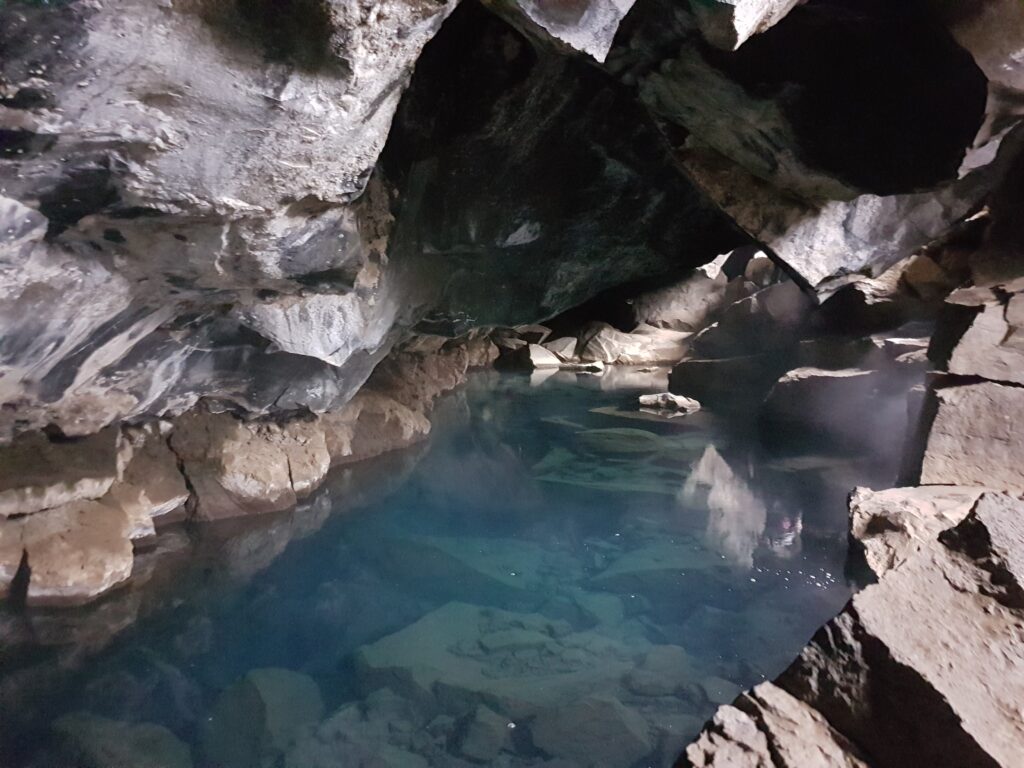
Hverfjall
A massive (1 km!) tephra crater that you can hike up for panoramic views of Lake Mývatn and its volcanic surroundings. One of the surpriing facts about this crater is that the depth of the crater bowl is equal to its height. There are two hiking paths that you can take to visit the crater, with the simple one having a 600 m hike uphill and a 3.2 km hike around the caldera.

Myvatn baths
Often called the “Blue Lagoon of the North,” this geothermal spa is less crowded and cheaper than the Blue Lagoon near Reykjavík. It’s a perfect way to relax after a day of hiking. The total lake surface is smaller than the Blue Lagoon, so it feels crowded.
Day 8 – West Iceland
Godafoss
Goðafoss waterfall, “Waterfall of the Gods” – one of the most beautiful waterfalls in Iceland, with a curved shape that makes it look like a mini Niagara Falls. This impressive waterfall has a height of 12 m high and is 30 m wide. The legend says that during the Christianity intake in Iceland, a local named Þorgeir Ljósvetningagoði threw pagan idols down the fall.
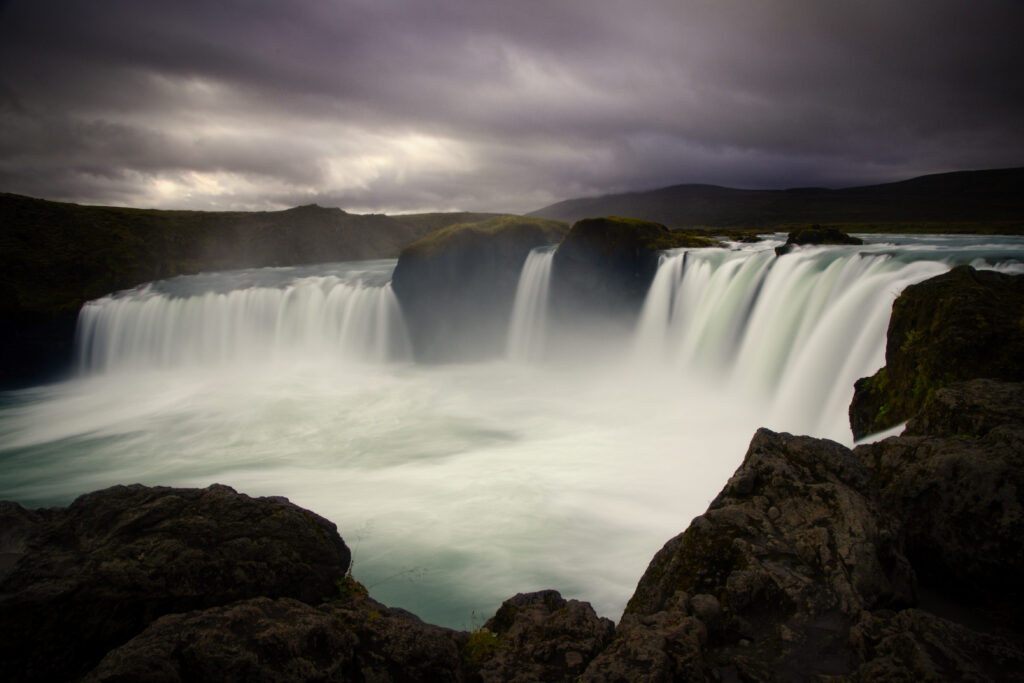
Gerduberg
The highlight of Gerduberg are the 7-14 m tall basalt columns with hexagonal shape that form a wall. We hike up but there’s nothing special to be seen from up, so unless you have a drone, I recommend to stay on the lower part, from where you can see the columns.
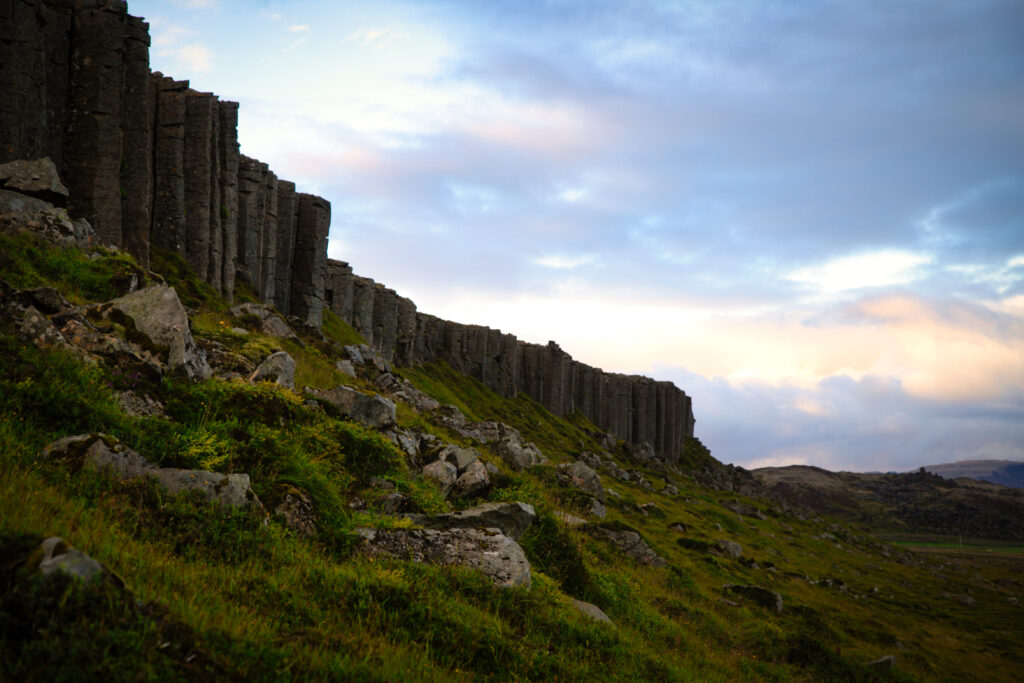
Kolugljúfur Canyon
Kolugljúfur is a nice gorge with a beautiful waterfall. The main highlight of this waterfall is that it’s less famous than other places, and thus less crowded. As you can see in the photo, the middle of the day is not the best time to visit, as you get weird shadows. Nonetheless, it’s a beautiful place.

Raudfeldsgjá
This is a very cool gorge. When you’re approaching, you’ll see a narrow gap. Once you’re inside, you will see how there’s a small river flowing through the gorge. You can walk a bit deeper, but eventually you’ll reach a small waterfall. There’s a cord, in case you want to continue the hike, but I wasn’t feeling so adventurous, so I went back.

Yrti Tunga
If you want to see wildlife, Yrtu Tunga is a great place. Here you can see plenty of seals chilling on the beach. While in Iceland you can have both harbor and grey seals, harbor seals are more common in Yrti Tunga. When we visited there was only three seals, chilling on the rocks. Be careful and don’t approach the seals, as they are wild animals.
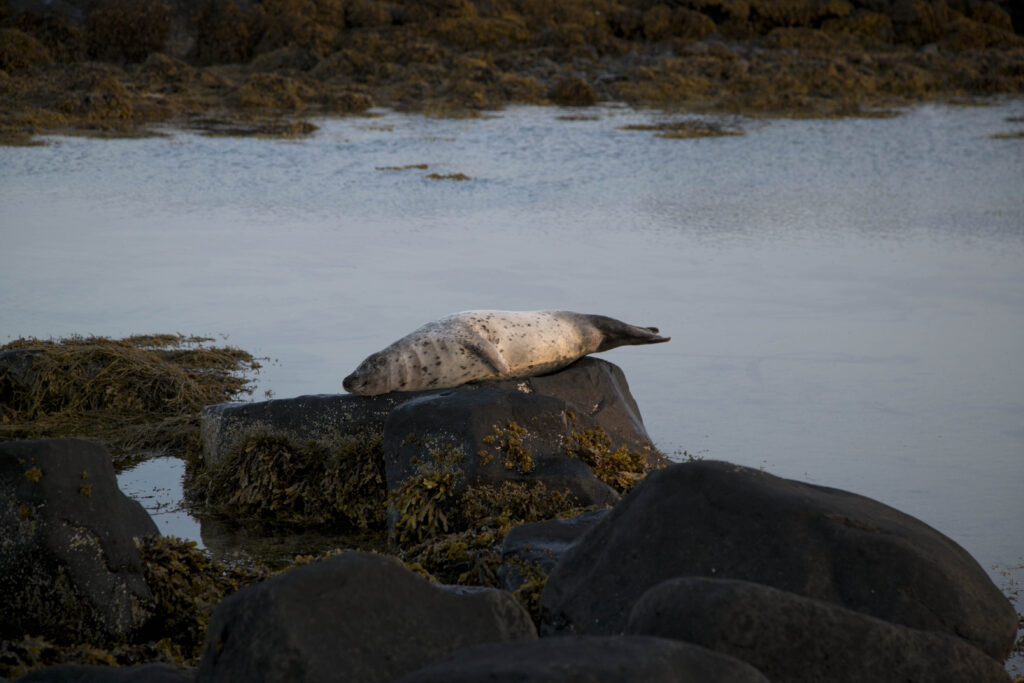
Day 9 – Return and visit to Reykjavík
Kirkjufell
Kirkjufell is one of the classic photospots of Icelands. The place is quite crowded, especially with photographers. It was quite difficult to get a photo with no people (cloning brush is here to help). While it certainly looks great in pictures, I wouldn’t say I was very impressed with it in real life – there’s more beautiful places in my opinion.
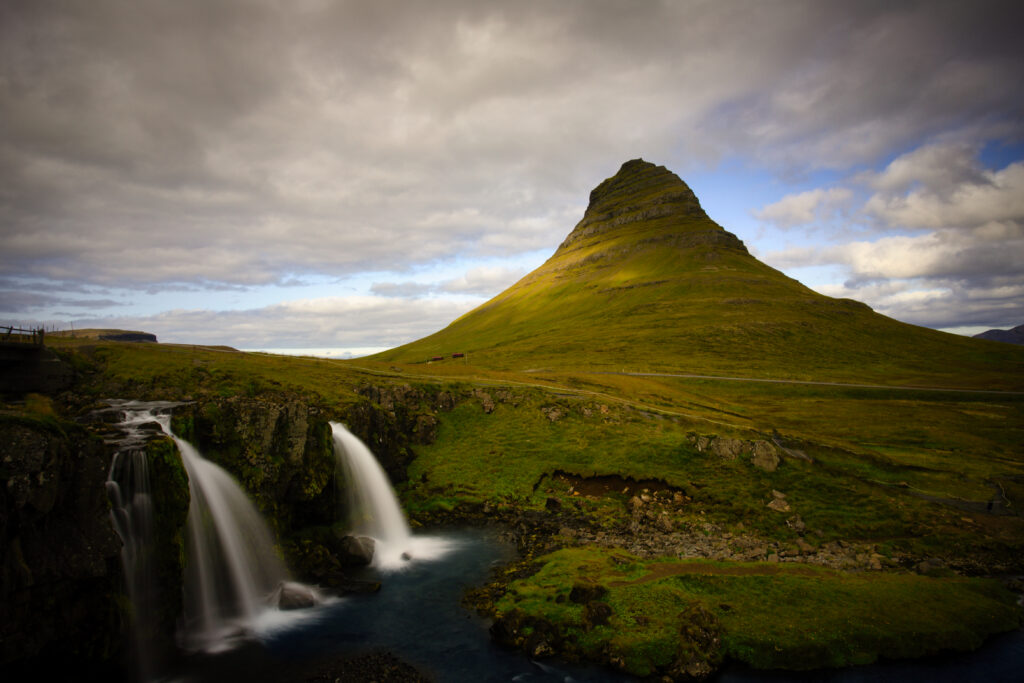
Djúpalínssandur
Djúpalínssandur is a black sand beach. It used to be a fishing village, but nowadays only some remains from these old times can be found on the beach. The most famous site is the English trawler wreck Epine GY7, from which you can see some oxidized metallic parts.

Lóndrangar
These basalt cliffs are a great last stop before heading back to Reykjavík to take your flight. Given its intersting shapes, there’s plenty of local folklore talking about Lóndrangar.
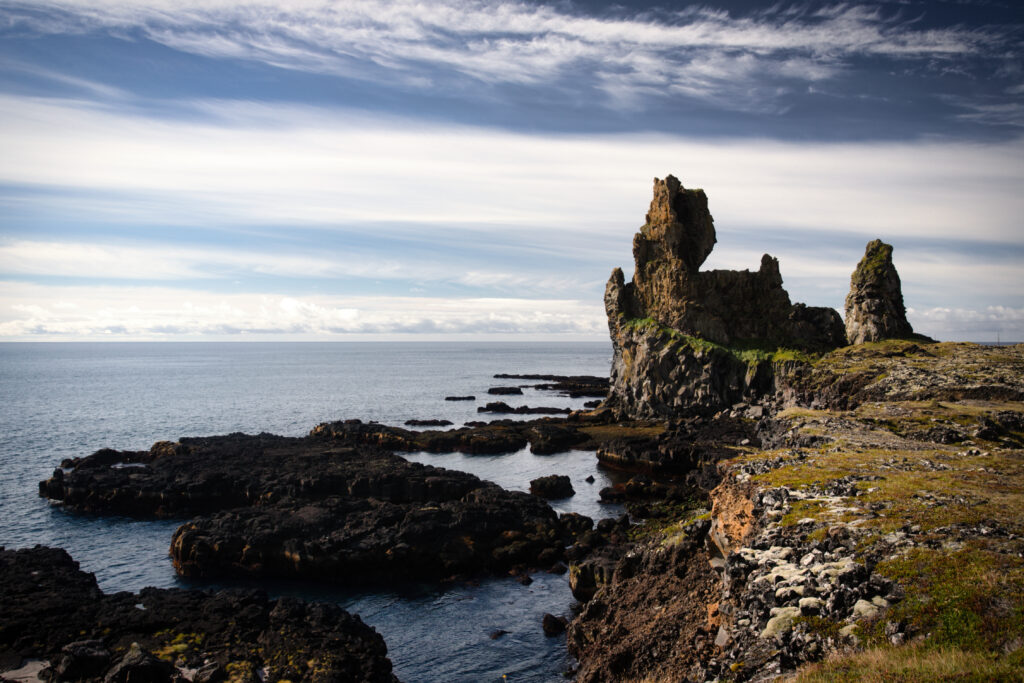
Head to the airport to return to your country
Final Thoughts
For me, Iceland is one of the best destinations out there. As someone who enjoys photography, Iceland is a dream. When I went, I still didn’t have my drone, but I really want to go back to explore and fly over the highlands. Is this Ring Road 9 day trip a bit rushed? Probably. You’ll see a lot of points if you do it (and I skipped many viewpoints here too!). From waterfalls and glaciers to small towns and hot springs, every day brought something new and unexpected.
Practical Tips for Driving Iceland’s Ring Road
Car rental
The first question that comes up to mind is which car to rent when in Iceland. That depends a lot on what your travel plans are:
- Sedan: This is the option to take if you plan to stay in hotels along the road. I’ve seen people sleeping in their sedans. Been there, done that, and I’m too old for this now. It gets quite cold at night, so it won’t be a great experience.
- Campervan: This was the option we chose. It offers more flexibility than a regular sedan – no need to plan in advance where you will stay, just drive from camping lot to camping lot. Renting a camper may not seem like the chepaest option, but think that you’ll be saving a lot on hotels (camping sites are much cheaper). We rented with Camper Rental Iceland and were happy with the service. The car was clean and functional, having all the kitchen and sleepware needed. A heater is a must for a campervan too.
- 4×4: If you want to explore the highlinds or are planning on driving one of the famous F-roads, you’ll need a 4×4. Even some of the accessible roads are not for the faint-hearted, so don’t risk it. The insurance of the regular rental cars also doesn’t cover the F-roads. The 4W are also essential if you plan to do some river crossing.
Fuel
The advice that I heard before going to Iceland was: fuel when you see gas station. This may not necessarily apply if you only want to do the Golden Circle, but it’s certainly uselful to do the Ring Road with peace of mind. If you’re going to the highlands, just buy extra fuel and put it in the truck of the car.
Temperature
Do you like experiencing the four seasons all in one day? You’re at the right place. It may be freezing cold one moment and half an hour later you’re removing all your layers because of the heat. Layers are essential there. Also, do you know these cute sweaters that they sell in Reykjavík? They’re typical there for a reason – nothing better than a warm sweater close by for the ever changing temperatures.
Iceland is also very windy and wind tends to make places cold (thinking of you, San Francisco). If you’re anything like me, your ears will get cold fast, so bring in a hat or some headwear to protect them, even in summer. Summer is cold there, don’t be tricked.
Budget
Islands are not cheap in general, and Iceland is no exception for that. Food is pricey and fresh foods are even pricier and more limited. Restaurants are quite expensive as well. I did bring some cans with me, which were quite handy in some situations, and bought some fresh foods there. There’s certainly ways to make the trip cheaper if you need to.
Another tip to save is to rent a camper to avoid staying in hotels. Some people skip the camping sites, but you’ll annoy the locals and may get fined, so I wouldn’t recommended it.
Camping
Beware that if you rent a campervan, that doesn’t mean you can stay anywhere. It used to be more flexible, but with the influx of tourism more norms have been put in place to protect the natural areas. So you’ll have to stay in camping sites. For most campings, there is no need to book in advance. I recommend bringing some cash, as especially the showers/bathrooms may need coins to be used.
Is the Ring Road easy to drive?
The answer is yes – the Ring Road is nicely paved and well-maintained road. However, be aware of the sheep. They’re dumb and will wait for the moment they see a car approaching to cross the road. Thus, respect the speed limits, otherwise you may crash into some sheep.
Currency
Iceland uses the icelandic krona (ISK). While most places (restaurants, hotels, gas stations, and supermarkets) accept cards, it’s always good to have some cash for smaller purchases, or especially if you plan going camping. You may need coins there too, so make sure you have some change.
How long should I spend on the Ring Road?
I would say that the minimum you should allow yourself to do the whole road is 7 days, so you get the time to drive around and see the main attractions. Obviously, the more time you have, the more you can visit. If you’re a nature lover, go with as many days as you can – the amount of varied landscapes that you’ll see and you’ll want to hike is never ending!